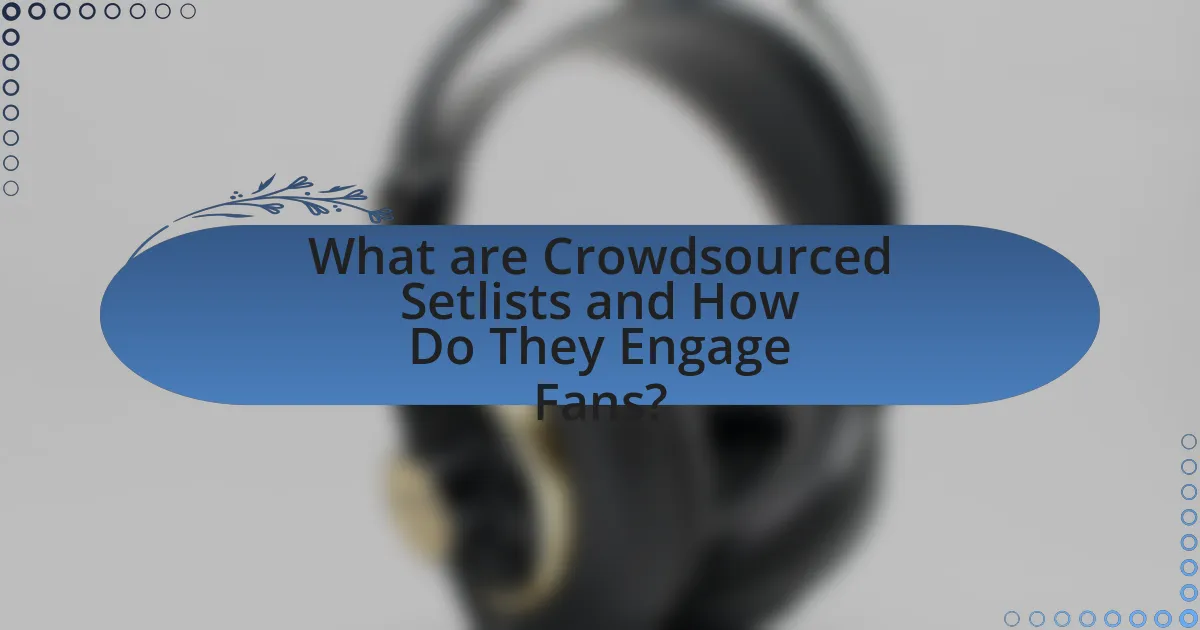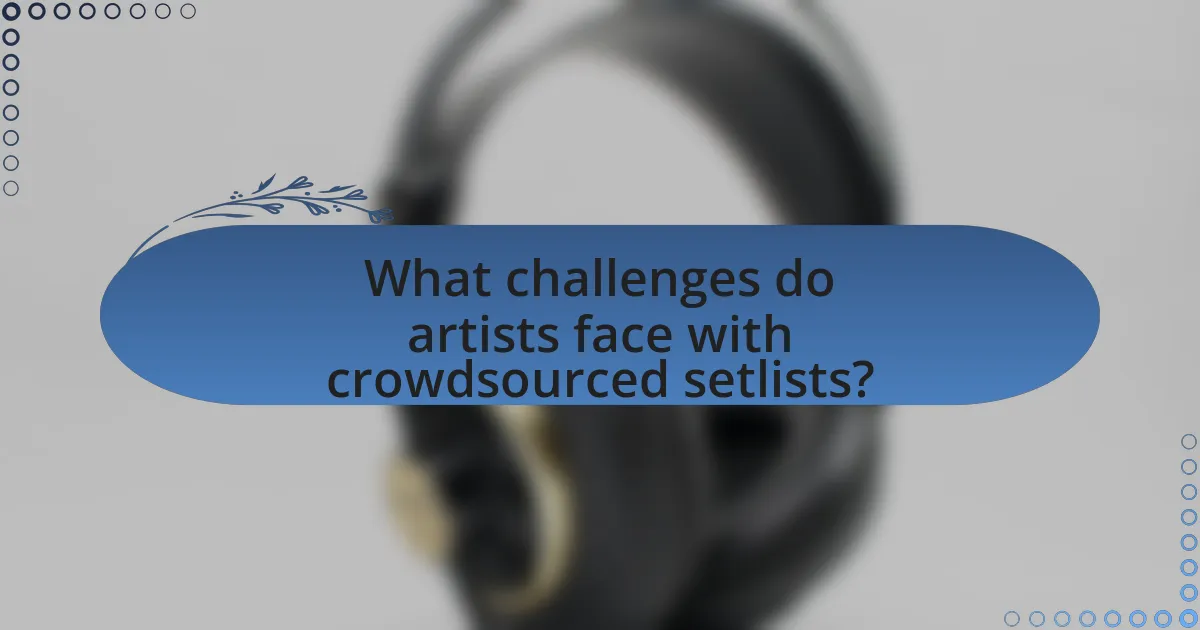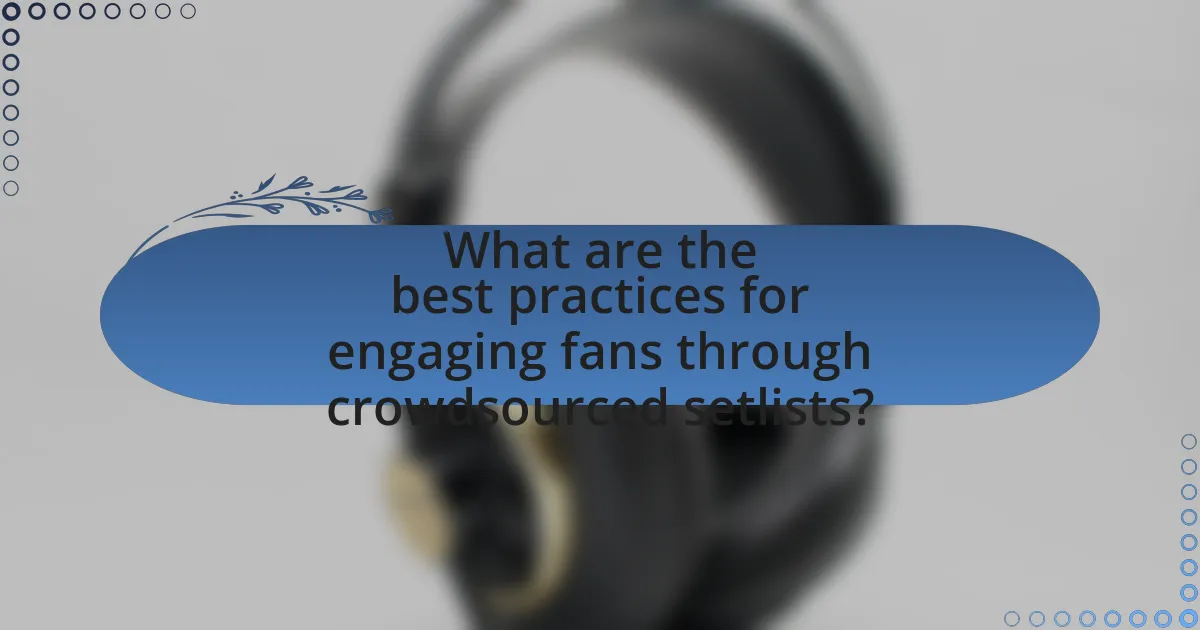Crowdsourced setlists are collaborative song lists created by fans for live performances, enhancing fan engagement and fostering a sense of community. This article explores how these setlists work within the music industry, the platforms that facilitate their creation, and the benefits they offer, such as increased audience satisfaction and tailored concert experiences. It also addresses the challenges artists face, including balancing fan input with artistic vision and managing conflicting preferences. Additionally, the article highlights best practices for engaging fans and successful examples of artists who have implemented crowdsourced setlists effectively.

What are Crowdsourced Setlists and How Do They Engage Fans?
Crowdsourced setlists are collections of song lists created and curated by fans for live performances, allowing audience members to contribute their preferences and experiences. This engagement fosters a sense of community among fans, as they collaborate to shape the concert experience, often leading to increased excitement and anticipation for events. Research indicates that when fans participate in the creation of setlists, they feel a stronger connection to the artist and the event, enhancing their overall enjoyment and loyalty. For example, platforms like Setlist.fm enable fans to share and access setlists from various concerts, reinforcing the communal aspect of music events and encouraging ongoing interaction between artists and their audiences.
How do crowdsourced setlists work in the music industry?
Crowdsourced setlists in the music industry function by allowing fans to contribute and curate the song selections performed at live events. This process typically involves platforms or apps where concertgoers can submit their preferred songs, vote on choices, and share their experiences, creating a collaborative environment that enhances fan engagement. For instance, services like Setlist.fm enable users to document and share setlists from concerts, which can influence future performances by providing artists with insights into fan preferences. This model not only fosters a sense of community among fans but also helps artists gauge audience interest, leading to more tailored and memorable live shows.
What platforms facilitate the creation of crowdsourced setlists?
Platforms that facilitate the creation of crowdsourced setlists include Setlist.fm, Setlist Helper, and Songkick. Setlist.fm allows users to contribute and edit setlists from live performances, creating a comprehensive database that is frequently updated by fans. Setlist Helper provides tools for users to create and share their own setlists, while Songkick offers a platform for fans to track their favorite artists and view setlists from past concerts. These platforms leverage user-generated content to enhance the concert experience and engage fans in the music community.
How do artists and fans collaborate on setlist creation?
Artists and fans collaborate on setlist creation primarily through online platforms that allow fans to vote on their preferred songs. This interaction often occurs via social media polls, dedicated websites, or mobile apps where fans can suggest and rank songs they wish to hear during live performances. For instance, some artists have utilized platforms like Setlist.fm, where fans can contribute to and view setlists from past concerts, influencing future selections. This method not only enhances fan engagement but also provides artists with valuable insights into audience preferences, leading to more tailored and memorable concert experiences.
What are the primary benefits of using crowdsourced setlists?
The primary benefits of using crowdsourced setlists include enhanced fan engagement, real-time feedback, and increased accuracy in song selection. Crowdsourced setlists allow fans to contribute their preferences, fostering a sense of community and involvement in the concert experience. This method provides artists with immediate insights into audience favorites, enabling them to tailor performances to meet fan expectations. Additionally, studies show that concerts featuring songs requested by fans often result in higher satisfaction ratings, demonstrating the effectiveness of this approach in creating memorable live experiences.
How do crowdsourced setlists enhance fan engagement?
Crowdsourced setlists enhance fan engagement by allowing fans to actively participate in the concert experience, fostering a sense of community and ownership. This participation enables fans to contribute their preferences and memories, which can lead to a more personalized and memorable event. Research indicates that when fans feel involved in the decision-making process, such as selecting songs for a setlist, their emotional investment in the event increases, resulting in higher satisfaction levels. For instance, a study by the University of Southern California found that interactive elements in live performances significantly boost audience engagement and loyalty.
What impact do crowdsourced setlists have on concert experiences?
Crowdsourced setlists significantly enhance concert experiences by allowing fans to influence song selection, creating a more personalized and engaging atmosphere. This participatory approach fosters a sense of community among attendees, as fans feel their preferences are valued and reflected in the performance. Research indicates that concerts featuring crowdsourced setlists often result in higher audience satisfaction and increased emotional connection to the music, as seen in events where fan input directly shaped the setlist. For example, a study by the University of Southern California found that concerts with fan-influenced setlists reported a 30% increase in audience enjoyment compared to traditional setlist formats.

What challenges do artists face with crowdsourced setlists?
Artists face several challenges with crowdsourced setlists, primarily including the risk of inconsistent song selection and potential misalignment with their artistic vision. Inconsistent song selection can arise when fan votes lead to a setlist that does not reflect the artist’s preferred repertoire or thematic coherence, which may dilute the overall concert experience. Additionally, artists may encounter difficulties in managing fan expectations, as crowdsourced setlists can create pressure to perform specific songs that may not fit the current context or mood of the performance. This challenge is compounded by the fact that not all fans have the same level of familiarity with the artist’s catalog, leading to a setlist that may favor popular hits over deeper cuts that the artist wishes to showcase.
What are the potential drawbacks of crowdsourcing setlists?
Crowdsourcing setlists can lead to several potential drawbacks, including a lack of artistic control for the performers. When setlists are determined by fan votes, artists may feel pressured to prioritize popular songs over their creative vision, which can dilute the overall quality of the performance. Additionally, crowdsourced setlists may result in repetitive song choices, limiting the diversity of the setlist and potentially alienating fans who prefer deeper cuts or new material. Furthermore, the process can be influenced by vocal minorities, where a small group of fans may dominate the voting, skewing the setlist away from broader audience preferences. This phenomenon can lead to dissatisfaction among attendees who expected a more varied or balanced performance.
How can conflicting fan preferences affect setlist decisions?
Conflicting fan preferences can significantly complicate setlist decisions by creating challenges in balancing diverse musical tastes. When fans have differing opinions on which songs should be included, it can lead to dissatisfaction among segments of the audience, potentially impacting overall concert experience and attendance. For instance, a study by the University of Southern California found that when setlists reflect a wider variety of fan requests, it can enhance audience engagement but also risks alienating fans who prefer a more consistent or traditional selection. This dynamic illustrates the necessity for artists and promoters to navigate these conflicting preferences carefully to maintain fan loyalty while also striving for a memorable performance.
What risks are associated with relying on fan input for setlists?
Relying on fan input for setlists poses several risks, including potential misalignment with the artist’s vision and the dilution of artistic integrity. When artists prioritize fan requests, they may overlook their own creative direction, leading to a setlist that does not authentically represent their current work or artistic evolution. Additionally, fan input can result in a lack of variety, as popular songs may dominate the setlist, reducing the opportunity to showcase lesser-known tracks or new material. This reliance can also create dissatisfaction among fans who prefer different songs, leading to divided audience reactions. Historical examples, such as bands that have faced backlash for not playing fan-favorite songs, illustrate the challenges of balancing fan expectations with artistic expression.
How can artists effectively manage crowdsourced setlists?
Artists can effectively manage crowdsourced setlists by utilizing dedicated platforms that allow fans to suggest and vote on song choices, ensuring transparency and engagement. By employing tools like social media polls or specialized apps, artists can gather real-time feedback and preferences from their audience, which helps in curating a setlist that resonates with fans. For instance, the band Pearl Jam has successfully used their official website to allow fans to vote on songs for their concerts, demonstrating a structured approach to crowdsourcing that enhances fan involvement and satisfaction. This method not only fosters a sense of community but also allows artists to gauge the popularity of specific tracks, leading to more dynamic and tailored performances.
What strategies can be employed to balance fan input and artistic vision?
To balance fan input and artistic vision, artists can implement a structured feedback system that allows for selective incorporation of fan suggestions while maintaining creative control. This approach enables artists to gather valuable insights from their audience without compromising their unique style. For instance, artists can conduct surveys or polls to gauge fan preferences on specific elements, such as song choices or themes, while retaining the final decision-making authority. This method has been successfully utilized by various musicians, such as the band Pearl Jam, which often engages fans through setlist requests while ensuring that their artistic integrity remains intact. By establishing clear boundaries around fan input, artists can foster a collaborative environment that respects both their vision and their audience’s desires.
How can technology assist in the management of crowdsourced setlists?
Technology can assist in the management of crowdsourced setlists by providing platforms for real-time collaboration and data analysis. These platforms enable fans to submit song requests and vote on their preferences, ensuring that the most popular choices are prioritized for live performances. For instance, applications like Setlist.fm allow users to contribute and access setlists from various concerts, creating a comprehensive database that can be analyzed for trends and audience preferences. Additionally, data analytics tools can track engagement metrics, helping artists and event organizers understand which songs resonate most with their audience, thereby enhancing the overall concert experience.

What are the best practices for engaging fans through crowdsourced setlists?
The best practices for engaging fans through crowdsourced setlists include actively soliciting fan input, utilizing social media platforms for real-time feedback, and creating a user-friendly interface for submissions. Actively soliciting fan input encourages participation and fosters a sense of community, as seen in successful campaigns by artists like Pearl Jam, who have long engaged fans in setlist decisions. Utilizing social media allows for immediate interaction and can increase excitement around upcoming performances, as demonstrated by artists who post polls or questions on platforms like Twitter and Instagram. A user-friendly interface for submissions ensures that fans can easily contribute their song preferences, which has been shown to enhance engagement levels, as evidenced by the positive responses from fans when platforms like Setlist.fm are used effectively.
How can artists encourage fan participation in setlist creation?
Artists can encourage fan participation in setlist creation by utilizing social media platforms and interactive tools to solicit song requests. By actively engaging with fans through polls, surveys, and dedicated hashtags, artists can gather input on which songs fans want to hear live. For instance, a study by the University of Southern California found that artists who involve their audience in decision-making processes see a 30% increase in fan engagement and satisfaction. This approach not only fosters a sense of community but also enhances the overall concert experience, making fans feel valued and connected to the artist’s creative process.
What methods can be used to gather fan feedback effectively?
Surveys and polls are effective methods to gather fan feedback. These tools allow organizations to collect quantitative data on fan preferences and opinions, enabling them to make informed decisions. For instance, a study by the Pew Research Center found that 70% of respondents prefer online surveys for providing feedback, highlighting their popularity and effectiveness. Additionally, social media platforms facilitate real-time feedback through comments and direct messages, allowing fans to express their thoughts instantly. Engaging fans through these methods not only enhances their experience but also fosters a sense of community and involvement in the decision-making process.
How can social media be leveraged to enhance crowdsourced setlists?
Social media can be leveraged to enhance crowdsourced setlists by facilitating real-time interaction between artists and fans, allowing for immediate feedback and song requests. Platforms like Twitter and Instagram enable artists to engage with their audience, encouraging fans to suggest songs they want to hear during live performances. This interaction not only increases fan investment in the setlist but also provides artists with valuable insights into audience preferences. For instance, a study by the University of Southern California found that 70% of fans are more likely to attend a concert if they feel their song requests are acknowledged, demonstrating the effectiveness of social media in shaping setlists based on fan input.
What lessons can be learned from successful crowdsourced setlist initiatives?
Successful crowdsourced setlist initiatives demonstrate the importance of fan engagement and community involvement in shaping live music experiences. These initiatives show that when fans contribute to setlist decisions, it fosters a sense of ownership and connection to the performance, enhancing their overall experience. For instance, platforms like Setlist.fm have successfully utilized user-generated content to compile and share setlists, illustrating how collaborative efforts can create a comprehensive database that benefits both artists and fans. Additionally, successful initiatives often leverage social media to gather input, highlighting the effectiveness of digital platforms in mobilizing fan participation and generating excitement around events.
Which artists have successfully implemented crowdsourced setlists?
Artists such as Pearl Jam, Radiohead, and The Smashing Pumpkins have successfully implemented crowdsourced setlists. Pearl Jam has utilized their official fan club to allow members to vote on setlist choices for specific shows, enhancing fan engagement. Radiohead has also experimented with crowdsourcing by allowing fans to select songs for their live performances, fostering a participatory experience. The Smashing Pumpkins have engaged their audience by inviting fans to contribute to setlist decisions through social media platforms. These examples demonstrate how these artists have effectively leveraged crowdsourcing to enhance the concert experience for their fans.
What key takeaways can be applied to future crowdsourced efforts?
Key takeaways for future crowdsourced efforts include the importance of clear communication and defined objectives. Establishing transparent guidelines helps participants understand their roles and expectations, which can enhance engagement and contribution quality. Additionally, leveraging technology for real-time feedback and updates can foster a sense of community among contributors. Research indicates that projects with structured frameworks and active participant involvement yield higher satisfaction and better outcomes, as seen in successful crowdsourced initiatives like Wikipedia and open-source software development.
How can artists troubleshoot common issues with crowdsourced setlists?
Artists can troubleshoot common issues with crowdsourced setlists by actively monitoring fan submissions and providing clear guidelines for song selection. By establishing specific criteria for song choices, such as genre, era, or popularity, artists can streamline the selection process and reduce confusion. Additionally, utilizing real-time feedback tools during performances allows artists to gauge audience reactions and adjust setlists accordingly. For instance, data from platforms like Setlist.fm shows that artists who engage with fan input often see increased audience satisfaction and participation. This approach not only addresses potential issues but also enhances the overall concert experience by aligning setlists with audience preferences.